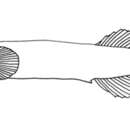Comprehensive Description
(
Anglèis
)
fornì da Smithsonian Contributions to Zoology
Tyson belos
This new species is so distinctive that only a diagnostic description is given here. The description is supplemented by the generic diagnosis presented above and the osteological description (p. 7). Characters of the holotype are indicated by an asterisk.
HOLOTYPE.—AMS I.22583-031; 19.0±0.5 mm SL; sex unknown (immature); Australia, Queensland, Escape Reef, outer barrier, coral bottom, depth 29 m; coll. 29 Oct 1981 by G. Allen, W. Starck, and T. Ayling.
PARATYPES.—USNM 229985, 18.8 mm SL, ripe female, Papua-New Guinea, Trobriand Islands, west side Kiriwina Island, coral reef, coll. 19 Sep 1975 by T.R. Roberts; specimen now cleared, stained, and dissected. USNM 233515, 12.9 and 16.2 mm SL, sexes unknown, Fiji, Lau Islands, Ono-ilau, outside barrier reef on northwest side of island, depth ~13.7 to ~16.8 m, coll. 1 May 1982 by V.G. Springer et al.
DESCRIPTION.—Dorsal fin 1,9 to 1,10* (1,8 to 1,9* if last two rays are counted as one; see Figure 18). Anal fin 1,9 to 1,10* (1,8 to 1,9* if last two rays are counted as one). Pectoral fins 17*, 18, or 21. Pelvic fins not joined, each consisting of a single, unbranched, segmented ray (no spine). Caudal fin emarginate, with 8* or 9 dorsal procurrent rays; 3 to 5* simple, segmented dorsal rays; 4* or 5 branched, segmented dorsal rays; 3* or 4 branched, segmented ventral rays; 3 to 5* simple, segmented ventral rays; and 9* ventral procurrent rays, for a total of 33 or 34* elements, of which 15 or 17* are segmented, and of these 7* to 9 are branched. Vertebrae 13* + 13* = 26*. Branchiostegals 6*. Scales, gill rakers, sensory pores (except anterior and posterior nostrils) lacking.
Anterior nostril borne on short tube; tube, when depressed, reaches to upper lip; posterior nostril a simple pore just posterior to base of tube of anterior nostril.
Gill openings of holotype and largest paratype extend anteriorly to below level of middle of orbit; in smallest paratypes, to below level of posterior third of orbit.
Color in alcohol: ground color of body pale with few patches of melanophores. Holotype and smallest and largest paratypes each have patch of melanophores on midside of caudal peduncle. Holotype and largest paratype have patches of melanophores posteriorly on dorsal and anal fins. In holotype, dorsal- and anal-fin melanophore patches are extensive, intensive, and occupy approximately same relative area as anal-fin melanophore patch of largest paratype. Dorsal-fin melanophore patch of largest paratype much reduced in area; patch completely absent in two smallest paratypes.
A color transparency photograph (in the USNM collections) taken of the freshly collected holotype is noteworthy mainly for the specimen's exhibiting an irregularly shaped, pinkish spot posteroventrally on the lateral surface of the head, and for a pale rust-colored perfusion about the melanophores on the caudal peduncle. Similar rust-colored areas are also present on the ventrolateral portions of the head and abdomen.
- sitassion bibliogràfica
- Springer, Victor G. 1983. "Tyson belos, new genus and species of Western Pacific fish (Gobiidae, Xenisthminae) : with discussions of Gobioid osteology and classification." Smithsonian Contributions to Zoology. 1-40. https://doi.org/10.5479/si.00810282.390

